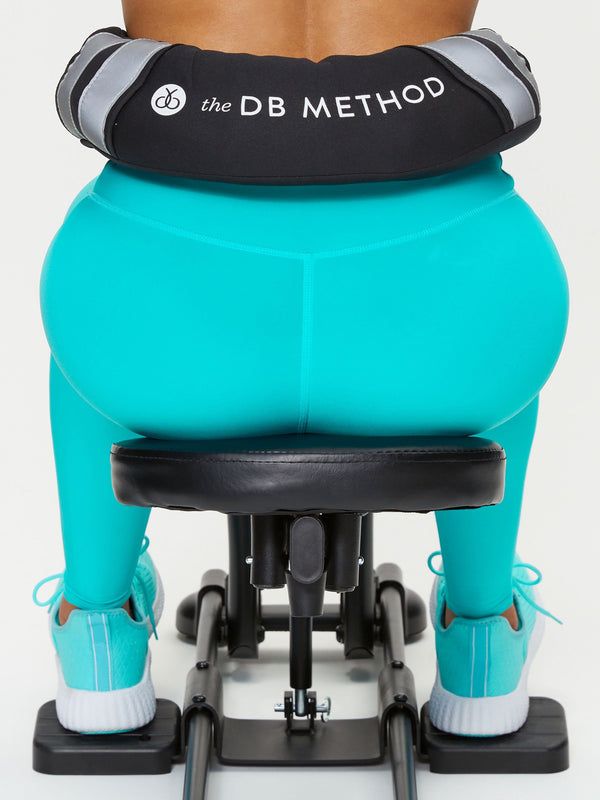If you're experiencing leg cramps regularly, you're no stranger to the discomfort they can cause and how they "cramp" your style. However, a simple solution to preventing these cramps may be to increase how much magnesium you get daily.
Magnesium deficiencies often lead to leg cramps, which is why it is important to pay attention to your absorption and intake levels. While magnesium can be a helpful way to prevent leg cramps, your body only absorbs a limited amount (about 30-40%) in the foods you eat. But don't worry about the absorption level, it combines with other essential minerals like calcium and potassium to keep your muscles relaxed and flexible.
This collaboration supplies your muscles with the required oxygen and nutrients needed to function while reducing any built-up metabolites and swelling. This combined effort also improves your blood flow and stabilizes your nerve impulses. So if you’re a bit short on magnesium, these combinations help to boost each other to keep your leg cramps at bay.
But magnesium deficiencies aren’t the only causes of leg cramps, so it is important to first determine the cause before trying to fix them.
*Always talk to your doctor before trying any new treatments as only they know your medical history and can make recommendations based on your needs.
The Types of Leg Cramps Magnesium May Be Able to be Used For:
- Nerve Dysfunction
- Overworked Leg Muscles
- Dehydration
- Medications
- Pregnancy
Nerve Dysfunction
Nerve dysfunction causes leg cramps by disrupting the signaling between your nerves and the muscles in your legs.
Magnesium prevents muscle cramps by reducing your nerve sensitivity and stopping the release of calcium from your nerve endings (source). This reduces the sensitivity of your nerves and blocks the release of calcium diminishing the muscular contractions. In turn, it reduces the cramps and your discomfort.
Overworked Leg Muscles
Overworked leg muscles trigger leg cramps because your exhausted muscles lose their ability to regulate their contractions.
Magnesium releases the tension in your leg muscles keeping your muscle cells from getting overworked (source). Releasing tension also removes any lactic acid buildup and promotes good blood flow to your legs.
Dehydration
Electrolytes like potassium and magnesium are crucial for maintaining your body's fluid balance. And this intern helps ensure proper nerve and muscle function. Your electrolyte levels decrease when you are dehydrated, leading to cramps that can occur throughout your body. And painful muscle contractions in your legs are more common with dehydration since you use your leg muscles more frequently.
Dehydration also lowers your blood volume making it harder for your blood to circulate and deliver oxygen and nutrients to your muscles. The result is muscle fatigue and leg cramping. Since magnesium helps regulate the balance of electrolytes in your body, a magnesium deficiency can lead to leg spasms (source).
Medications
Some medications cause cramps because they affect electrolyte levels and the circulation in your legs. Since these medications interfere with some of your body's normal functioning, it’s more likely that you'll experience cramping in your legs.
Here's a closer look at how certain medications can lead to leg cramps:
- Diuretics increase your urine production and result in an electrolyte imbalance.
- Statins are medications that lower your cholesterol levels and increase how much calcium enters your muscle cells.
- Blood pressure medications like beta blockers reduce high blood pressure. And the reduced blood flow to your legs can result in cramps.
- Corticosteroids imitate the effects of the hormones produced by your adrenal gland. They can interfere with the balance of potassium and calcium in your body, affecting your muscle function and increasing your risk of leg cramping.
Taking magnesium supplements may offer relief if you are experiencing cramps from your medication. Magnesium unwinds your muscles while adjusting your electrolytes and boosting your nerve functions to reduce the frequency and severity of muscle cramps (source). Just make sure you talk to your doctor as you don’t want to take anything that would interfere with your medication, or other health issues.
Pregnancy
Leg cramps can occur during pregnancy due to weight gain, hormonal changes, changes in circulation, and increased pressure on blood vessels. The pressure exerted from your growing uterus on the blood vessels reduces the blood flow to your legs. Your body during pregnancy also requires more magnesium (due to the growing fetus), so it is more easy to become deficient.
Magnesium relieves cramps during pregnancy by relaxing your muscles and improving your sleep quality. And with the extra weight your legs carry, they may be more exhausted and prone to cramping. Improving the quality of your sleep helps your muscles recover faster because your body produces hormones that aid in the growth and repair of your leg muscles. (additional source.)
Now that you know what can cause a magnesium deficiency, lets look at the recommended amounts of magnesium to aim to consume daily. This starts with testing magnesium levels and adjusting the foods you eat.
Testing Your Magnesium Levels and Determining the Recommended Amounts
Here are several ways to determine if you are meeting your magnesium needs with food:
- Measuring the magnesium levels in your blood is possible through a blood test, but it may not be very precise since only 1% of the magnesium in your body is present in your bloodstream.
- You can undergo a 24-hour urine test to assess the quantity of magnesium your body is excreting, which approximates the amount of magnesium you utilize.
- Magnesium deficiencies can cause various symptoms like muscle cramps, anxiety, sleep problems, and an irregular heartbeat. You may not get enough magnesium if you have any of these symptoms.
- You also can track your diet using a food diary or a mobile app to see how much magnesium you are getting from your diet.
Since the amount of magnesium you need to prevent leg cramps varies based on your age and gender, the following chart is a good starting point to find your daily recommended amount.
|
Age |
Amount of Magnesium Recommended |
|
Birth to 6 months |
30 mg |
|
Infants 7–12 months |
75 mg |
|
Children 1–3 years |
80 mg |
|
Children 4–8 years |
130 mg |
|
Children 9–13 years |
240 mg |
|
Teen boys 14–18 years |
410 mg |
|
Teen girls 14–18 years |
360 mg |
|
Men |
400–420 mg |
|
Women |
310–320 mg |
|
Pregnant teens |
400 mg |
|
Pregnant women |
350–360 mg |
|
Breastfeeding teens |
360 mg |
|
Breastfeeding women |
310–320 mg |
Source: National Institutes of Health
Now its time to find ways to increase magnesium levels within your diet. There are numerous foods and spices you can try as meals and snacks for a simple and effective solution. For example, add spinach to your salad or sandwich, snack on almonds as a mid-morning treat, or include black beans in a hearty soup or chili.
Here are some common magnesium-rich foods and their approximate magnesium content (per 100 grams):
|
Food |
Amount of Magnesium (mg) |
|
Mackerel |
76 mg |
|
Spinach |
79 mg |
|
Chickpeas |
79 mg |
|
Instant Oatmeal |
87 mg |
|
Salmon |
95 mg |
|
Brown Rice |
98 mg |
|
Oats |
138 mg |
|
Peanut butter |
159 mg |
|
Black Beans |
171 mg |
|
Quinoa |
197 mg |
|
Dark Chocolate (70-85% cocoa) |
228 mg |
|
Almonds |
270 mg |
|
Cashews |
292 mg |
|
Sunflower seeds |
325 mg |
|
Sesame seeds |
351 mg |
|
Brazil nuts |
376 mg |
|
Pumpkin Seeds |
592 mg |
Source: USDA National Nutrient Database
These values are approximate and may vary depending on the specific product, brand, and preparation method.
Including magnesium-rich spices in your cooking is another easy way to add more of this essential mineral into your diet. You can add basil to your pasta dishes, ginger to your stir-fries, or thyme to your roasted vegetables.
Common spices high in magnesium are (per 100 grams):
|
Spice |
Amount of Magnesium (mg) |
|
Basil |
64 mg |
|
Allspice |
135 mg |
|
Paprika |
178 mg |
|
Nutmeg |
183 mg |
|
Tumeric |
208 mg |
|
Ginger |
214 mg |
|
Rosemary |
220 mg |
|
Thyme |
220 mg |
|
Curry |
255 mg |
|
Oregano |
270 mg |
|
Cumin |
366 mg |
|
Mustard Seeds |
370 mg |
|
Sage |
428 mg |
|
Coriander |
694 mg |
Source: USDA National Nutrient Database
Even if you consume enough magnesium-rich foods to meet your daily recommended intake, your body may still not have enough. Age, genetics, certain health conditions, and specific medications can also affect your body's ability to absorb magnesium. But you don’t have to worry if you are still deficient because magnesium supplements can help ward off leg cramps (source)!
The absorption and effectiveness of magnesium can differ depending on its various forms, and certain forms are more appropriate for specific health issues.
Some forms of magnesium commonly used for leg cramps are:
- Magnesium citrate is a highly absorbable, gentle supplement for your digestive system that can help alleviate symptoms of anxiety and depression.
- Magnesium chloride is also easily absorbed and is available in tablets, capsules, liquids, and topical sprays, making it convenient if you get leg cramps in the middle of the night.
- Magnesium glycinate is a highly absorbable form of magnesium that is well-tolerated. It improves muscle function, alleviates insomnia, and doesn’t leave an aftertaste.
- Magnesium lactate is quickly absorbed, making it a gentle supplement for your digestive system. It reduces stress and anxiety and is safe enough to be prescribed during pregnancy.
- Magnesium malate is a specific form of magnesium that is quickly absorbed by your body, lowers your muscle pain, and is gentle on your digestive system because it neutralizes your stomach acid
- Magnesium oxide, also known as milk of magnesia, is a popular option to treat leg cramps because of its high magnesium content and its ability to prevent migraines.
- Magnesium sulfate, also known as Epsom salt, is often used in baths to relieve sore muscles, cramps, and tension and is absorbed through your skin. People frequently utilize magnesium as a laxative, and in a medical setting, it sees frequent use for treating eclampsia.
Magnesium is a well-tolerated nutrient commonly used to treat leg cramps. And if this is the cause of yours, talk to your doctor first and then use this guide to magnesium and leg cramps to help match your food and supplement intake so it works to alleviate your pain, and not "cramp" your style.








